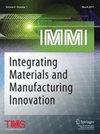CAROUSEL:一个高通量微观结构模拟的开源框架
IF 2.5
3区 材料科学
Q3 ENGINEERING, MANUFACTURING
Integrating Materials and Manufacturing Innovation
Pub Date : 2023-10-23
DOI:10.1007/s40192-023-00314-6
引用次数: 0
摘要
高通量筛选(HTS)可以显著加快新材料的设计,允许对大量材料成分和工艺参数进行自动测试。在集成计算材料工程(ICME)中使用HTS,可以在实证检验之前对多个组合进行计算评估,从而减少材料和资源的使用。进行计算HTS涉及应用高通量计算(HTC)和开发适当的工具来处理这种计算。在与HTS和HTC兼容的多种ICME方法中,被称为CALPHAD的相图计算方法获得了突出的地位。当热力学模型与动力学模拟相结合时,预测降水行为的整个历史是可能的。然而,大多数报道的基于calphad的HTS框架仅限于热力学建模或无法访问。本工作介绍了carousel -一个用于高通量微观结构模拟的开源框架。它的目的是探索各种合金成分,加工参数,和CALPHAD实现。CAROUSEL提供了一个易于交互的图形界面,用于高级模拟的脚本工作流程,计算分配系统和模拟数据管理。此外,CAROUSEL集成了可视化工具,用于探索生成的数据,并集成了整个过程建模,考虑了凝固和固态析出之间的相互作用。应用领域是各种金属制造过程中,沉淀行为是至关重要的。模拟结果可用于高档材料模型,从而涵盖不同的微观结构现象。目前的工作展示了CAROUSEL如何用于增材制造(AM),特别是用于研究不同的化学成分和热处理参数(例如,温度,持续时间)。本文章由计算机程序翻译,如有差异,请以英文原文为准。

CAROUSEL: An Open-Source Framework for High-Throughput Microstructure Simulations
Abstract High-throughput screening (HTS) can significantly accelerate the design of new materials, allowing for automatic testing of a large number of material compositions and process parameters. Using HTS in Integrated Computational Materials Engineering (ICME), the computational evaluation of multiple combinations can be performed before empirical testing, thus reducing the use of material and resources. Conducting computational HTS involves the application of high-throughput computing (HTC) and developing suitable tools to handle such calculations. Among multiple ICME methods compatible with HTS and HTC, the calculation of phase diagrams known as the CALPHAD method has gained prominence. When combining thermodynamic modeling with kinetic simulations, predicting the entire history of precipitation behavior is possible. However, most reported CALPHAD-based HTS frameworks are restricted to thermodynamic modeling or not accessible. The present work introduces CAROUSEL—an open-sourCe frAmewoRk fOr high-throUghput microStructurE simuLations. It is designed to explore various alloy compositions, processing parameters, and CALPHAD implementations. CAROUSEL offers a graphical interface for easy interaction, scripting workflow for advanced simulations, the calculation distribution system, and simulation data management. Additionally, CAROUSEL incorporates visual tools for exploring the generated data and integrates through-process modeling, accounting for the interplay between solidification and solid-state precipitation. The application area is various metal manufacturing processes where the precipitation behavior is crucial. The results of simulations can be used in upscale material models, thus covering different microstructural phenomena. The present work demonstrates how CAROUSEL can be used for additive manufacturing (AM), particularly for investigating different chemical compositions and heat treatment parameters (e.g., temperature, duration).
求助全文
通过发布文献求助,成功后即可免费获取论文全文。
去求助
来源期刊

Integrating Materials and Manufacturing Innovation
Engineering-Industrial and Manufacturing Engineering
CiteScore
5.30
自引率
9.10%
发文量
42
审稿时长
39 days
期刊介绍:
The journal will publish: Research that supports building a model-based definition of materials and processes that is compatible with model-based engineering design processes and multidisciplinary design optimization; Descriptions of novel experimental or computational tools or data analysis techniques, and their application, that are to be used for ICME; Best practices in verification and validation of computational tools, sensitivity analysis, uncertainty quantification, and data management, as well as standards and protocols for software integration and exchange of data; In-depth descriptions of data, databases, and database tools; Detailed case studies on efforts, and their impact, that integrate experiment and computation to solve an enduring engineering problem in materials and manufacturing.
 求助内容:
求助内容: 应助结果提醒方式:
应助结果提醒方式:


